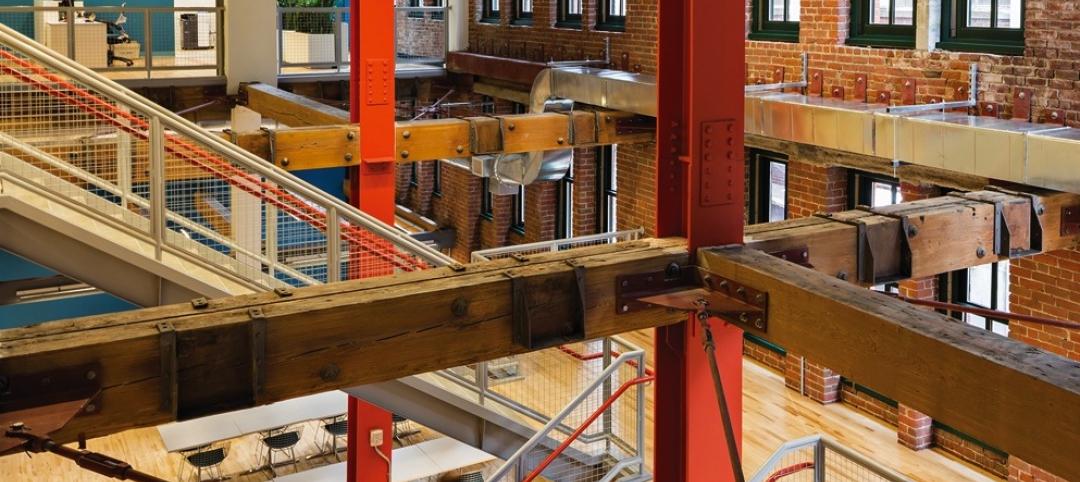The year was 2010, the economy was just starting to recover from the Great Recession, and Killefer Flammang Architects, better known as KFA, decided it was time for a corporate brand refresh. The chief question: Why was all of the firm’s work in Los Angeles?
In fact, that was not exactly the case, but it was true that the overwhelming majority of the firm’s work was concentrated in Los Angeles County and environs. “We realized that LA was who we were,” said Founder/CEO Wade Killefer, FAIA. “There’s tremendous value in knowing who you are and what you do. It makes everything so much easier.”
Partner and Principal John Arnold, AIA, credited the firm’s LA grounding—its motto: "KFA/Architecture for Los Angeles"—as the key to its success. “We have a string of developers who ask for our advice because we know our neighborhoods,” he said. “In about an hour we can tell them if a project might be okay to go forward or not.”
Over the past 40 years, KFA has designed more than 17,000 units of housing in over 300 different buildings for scores of developers in Los Angeles County. A dozen of these projects, comprising more than 1,000 affordable units, are on the city’s Skid Row. More than 40 of these buildings are of vintage quality; 11 are listed on the National Register of Historic Places. In recognition of these achievements, KFA received the 2016 AIA California Council Firm Award.
KFA didn’t start out with that sharp focus. Like most startups, it was just struggling to find its way.
FROM DESIGN-BUILD TO ADAPTIVE-REUSE CHAMPION
Killefer, a San Francisco native, grew up in Washington, D.C., and graduated from Stanford with a BA in English. He met his future wife and business partner Barbara Flammang when they both showed up late to class at UCLA’s School of Architecture and Urban Planning. In 1975, after earning an MArch degree, Killefer established a design-build company with partner Scott Carde, in Santa Monica. Two years later, Killefer and Flammang were married; in 1980, she joined the firm, then known as Carde Killefer Architects; it was renamed Killefer Flammang Architects in 2002. The firm became KFA, LLP (dba KFA Architecture), in 2016 and moved to Culver City last year.
In the early days, Flammang said, the goal was simple—“just try to do work we could be proud of, listen to clients and build relationships with them. We knew that if we delivered what the client wanted, shaped by us, it would lead to more work.”
They designed their first library in 1983, their first school two years later, and their first affordable housing project, in Santa Monica, in 1988. “That was a real milestone in terms of eventually doing a lot of affordable housing for a lot of great developers,” Killefer said.
As the new millennium rolled in, downtown LA was, by all accounts, a wasteland of once-grand older buildings that were all but abandoned. “Downtown was dead,” said Arnold. “The historic core had nothing but stereo stores and pawnshops. All these great buildings were 100% vacant above the first floor.”
Developers balked at the cost of bringing these venerable structures up to the city’s strict building code. To make redevelopment feasible Killefer helped update the city’s adaptive reuse ordinance (ARO). Under the revised ordinance, ARO projects no longer had to construct new parking or go through an entitlement phase. Fire/life safety, structural, and disabled access requirements were allowed to be more flexible with the historic buildings, which streamlined permitting and reduced construction costs.
At about this time, Tom Gilmore, a transplanted New York architect/developer, and his business partner Jerri Perrone, came into the picture. They purchased an entire block of abandoned historic buildings—the Continental, the Hellman, the San Fernando, and the Farmers and Merchants National Bank—in what they called the Old Bank District. Their firm, Gilmore Associates, was the first to use the new ARO, and they chose KFA as their architect.
It was the spark that lit the flame for downtown redevelopment. Los Angeles Magazine called the redevelopment of the Old Bank District “the most compelling urban neighborhood L.A. has spawned since the late 1800s.”
Once ARO was in place, Killefer asked his staff for volunteers to go downtown one weekend. Armed with aerial photos, they each took a block, evaluated every building on it, and determined which structures had potential for conversion to residential or other use. From these crude data points, they created a color-coded map—using Magic Markers—for downtown redevelopment.
“That map was one of the biggest things for us getting work,” said Arnold, who joined KFA in 1999. “Developers could look at the map and see which buildings might work for redevelopment.”
The product shifted from residential lofts to apartments, then to condos. “We learned how to be practical and integrate the historic fabric of a building without getting obsessed about it,” recalled Arnold. “Through 2009, we were the go-to firm for adaptive reuse downtown.”
After the recession the work shifted to converting prime historic buildings into hotels. Once these properties were all called for, KFA turned to converting defunct buildings from the 1950s, ’60s, and ’70s.
As the economy picked up, adaptive reuse took off in other parts of the region, notably Pasadena, Koreatown, Santa Monica, the San Fernando Valley, and Orange County; it continues to this day. In Long Beach, KFA is converting a 1980s glass office tower to residential use and adding a mid-rise structure over the adjacent parking garage.
For a huge region with limited greenfield development opportunities, adaptive reuse is a viable specialty for a mid-size architecture firm like KFA. “LA is all about adaptive reuse and infill,” said Arnold. “There are no farms left. It’s about having a vision to see the opportunity where it may not be obvious. We feel there’s enough work in LA to keep us busy for the lifetime of the firm.”
AN EMPHASIS ON LIVABILITY AND OPENNESS
KFA prides itself on listening closely to its clients, its own staff, governmental agencies, the project’s neighbors, even the project’s opponents.
“No one knows more about a neighborhood than the people who live there,” said Arnold. “Maybe the client or the neighborhood council has a good point. Most of the time, it makes the project better.”
Arnold recalled negotiating with the National Park Service on the conversion of a historic building to apartments. “They said the corridors were a character-defining feature that couldn’t be touched, but the walls, which were made of clay tile that would shatter in an earthquake, were not stacking,” he said. KFA proposed to first remove all the doors and finishes—the important architectural features—and then replace the walls to stack correctly while also making them earthquake resistant and reducing the overall seismic weight of the building. The last step: restoring the finishes to NPS standards. “We listened to them and found a solution that they could agree with,” said Arnold.
The firm’s paramount design focus is livability, working outward from deep inside the building. “That’s where we start, from the inside,” said Arnold. “Buildings are not just materials and form for the sake of the architectural vision. If someone gives me a building that looks great from the outside but has living units that are incompatible with livability, that is unacceptable to us.”
Livability is especially important in affordable housing projects, said Arnold. “Units have to be laid out so that you can furnish them properly,” he said. “I’ve seen so many projects where there’s no clear place to put a couch or a TV.” There has to be plenty of light and air, too, he said. “I remember one project where the living unit was long and deep and it had one little window off to the side that was put there to make the building look better on the outside,” said Arnold. “We simply won’t do that.”
KFA’s projects are also marked by the way they open up to the surrounding community. “That entry to the neighborhood has to be there so people feel connected or included or seen,” said Bornstein. “That is the stuff we would fall on our sword for.” As for narrow courtyards with no views to the outside, or courtyards that are enclosed on four sides,
“We avoid them, especially in these times where light and air is so important,” said Arnold.
The mantra at KFA, said Bornstein, is to “keep reminding ourselves the building has to love the people who will live there.” That’s not to say aesthetic considerations aren’t important. But sometimes, beauty comes from their reflection of the people who live there. I think that’s where we do our best work.”
LAYING THE GROUNDWORK FOR FUTURE LEADERSHIP
Earlier this year, as the coronavirus pandemic took hold and seven of its projects were put on hold, the firm had to lay off several staff. Work has picked up in recent months, and all but one of the laid-off employees has been rehired, bringing the total to 75.
After 45 years in the trenches, Killefer said he remains optimistic about the firm’s future. “We’re doing larger and larger campuses, bigger and bigger projects,” he said. “There’s a lot of housing left to be built in Los Angeles.”
Four years ago, Killefer and Flammang put a succession plan in place—neither of their children went into architecture, although their son became a developer—promoting Bornstein, Arnold, and Jonathan Watts to Partner.
Watts joined the firm in 2015, bringing an outsider’s perspective to the existing team, while also affirming KFA’s geographical focus. “As architects working to make Los Angeles a better place, we concentrate on how we can design to benefit the community and the client at the same time,” said Watts. “Community design is at the heart of what we do, but we also understand the forces that housing developers face. Efficient, well-considered design benefits both sides of the equation.
“Because we know the many diverse communities of Los Angeles, we bring this design focus to bear in very specific ways,” said Watts. “There is no single repeatable solution, so we go looking for the unique solution for each project.”
KFA CULTURE: WHERE GENDER EQUITY, DIVERSITY, AND ‘COLLABORATIVE AUTONOMY’ GUIDE THE WORKPLACE
Earlier this year, KFA Partner Barbara Flammang was named a Fellow of the American Institute of Architects not only for her work in transforming LA’s historic core but also for her “inclusive management practices that have tenaciously advanced gender equity and diversity.”
“The most important thing we can do as leaders is to provide an environment where people can do their best work,” Flammang said. “You have to challenge people to believe in themselves. They need to know that they are in charge of their success. No one else is.”
KFA’s staff has been 50% female for more than 30 years. “Almost all of our associates are women,” she said. “Potential employees have been drawn to KFA because they have seen that this is a place where women have learned, been mentored, and acquired responsibility.”
That’s what Lise Bornstein, AIA, experienced when she interviewed at KFA in 2001. “When I walked around the office, I saw women who were obviously leading projects and being heard,” she recalled. “That was it. I was going to be there.” She's now a Principal and Partner.
KFA is also notable for allowing staff members to test options for new roles within the company, a process Bornstein calls “collaborative autonomy.”
“‘Community’ is a thread that runs through everything we do,” said Bornstein, who handles all staff hiring. One example: KFA's work on the Los Angeles LGBT Center, Anita May Rosenstein Campus, for which it received the AIALA Presidential Honoree Award in 2019.
Related Stories
| Aug 6, 2014
Multifamily Sector Giants: Younger consumers, Sunbelt renaissance energize multifamily housing [2014 Giants 300 Report]
Multifamily housing construction is expected to remain relatively strong throughout 2014. Starts picked up in 2013, with completions due to catch up this year, finally approaching pre-recession levels, according to BD+C's 2014 Giants 300 Report.
| Jul 30, 2014
German students design rooftop solar panels that double as housing
Students at the Frankfurt University of Applied Sciences designed a solar panel that can double as living space for the Solar Decathlon Europe.
| Jul 28, 2014
Reconstruction market benefits from improving economy, new technology [2014 Giants 300 Report]
Following years of fairly lackluster demand for commercial property remodeling, reconstruction revenue is improving, according to the 2014 Giants 300 report.
| Jul 28, 2014
Reconstruction Sector Construction Firms [2014 Giants 300 Report]
Structure Tone, Turner, and Gilbane top Building Design+Construction's 2014 ranking of the largest reconstruction contractor and construction management firms in the U.S.
| Jul 28, 2014
Reconstruction Sector Engineering Firms [2014 Giants 300 Report]
Jacobs, URS, and Wiss, Janney, Elstner top Building Design+Construction's 2014 ranking of the largest reconstruction engineering and engineering/architecture firms in the U.S.
| Jul 28, 2014
Reconstruction Sector Architecture Firms [2014 Giants 300 Report]
Stantec, HDR, and HOK top Building Design+Construction's 2014 ranking of the largest reconstruction architecture and architecture/engineering firms in the U.S.
| Jul 23, 2014
Architecture Billings Index up nearly a point in June
AIA reported the June ABI score was 53.5, up from a mark of 52.6 in May.
| Jul 22, 2014
Herzog & de Meuron unveil curvy concrete condo in Manhattan
Herzog & de Meuron have released renderings of their new $250 million New York building, a 12-story condominium with 88 luxury apartments.
| Jul 21, 2014
Economists ponder uneven recovery, weigh benefits of big infrastructure [2014 Giants 300 Report]
According to expert forecasters, multifamily projects, the Panama Canal expansion, and the petroleum industry’s “shale gale” could be saving graces for commercial AEC firms seeking growth opportunities in an economy that’s provided its share of recent disappointments.
| Jul 18, 2014
Contractors warm up to new technologies, invent new management schemes [2014 Giants 300 Report]
“UAV.” “LATISTA.” “CMST.” If BD+C Giants 300 contractors have anything to say about it, these new terms may someday be as well known as “BIM” or “LEED.” Here’s a sampling of what Giant GCs and CMs are doing by way of technological and managerial innovation.














